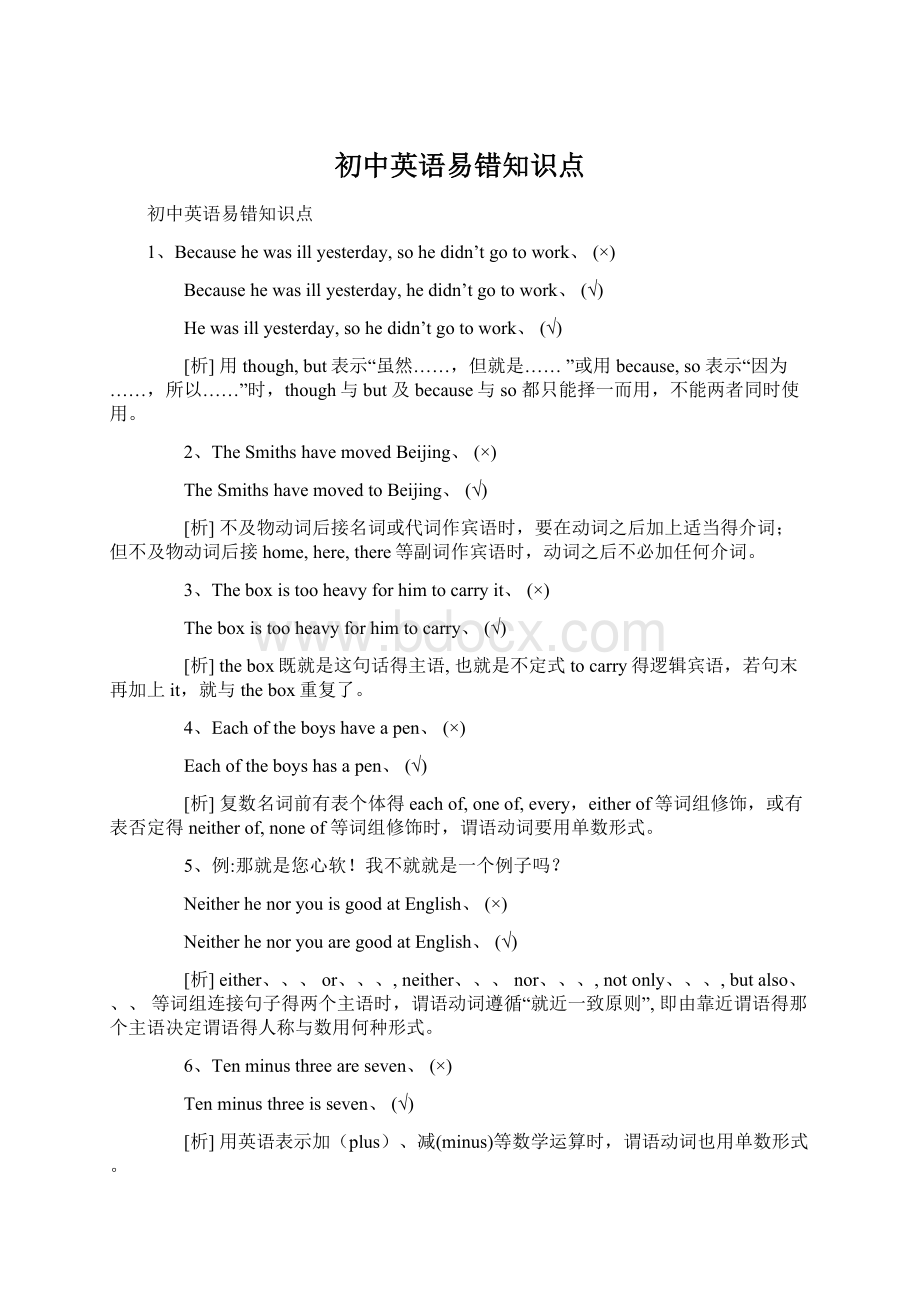初中英语易错知识点.docx
《初中英语易错知识点.docx》由会员分享,可在线阅读,更多相关《初中英语易错知识点.docx(26页珍藏版)》请在冰豆网上搜索。

初中英语易错知识点
初中英语易错知识点
1、Becausehewasillyesterday,sohedidn’tgotowork、(×)
Becausehewasillyesterday,hedidn’tgotowork、(√)
Hewasillyesterday,sohedidn’tgotowork、(√)
[析]用though,but表示“虽然……,但就是……”或用because,so表示“因为……,所以……”时,though与but及because与so都只能择一而用,不能两者同时使用。
2、TheSmithshavemovedBeijing、(×)
TheSmithshavemovedtoBeijing、(√)
[析]不及物动词后接名词或代词作宾语时,要在动词之后加上适当得介词;但不及物动词后接home,here,there等副词作宾语时,动词之后不必加任何介词。
3、Theboxistooheavyforhimtocarryit、(×)
Theboxistooheavyforhimtocarry、(√)
[析]thebox既就是这句话得主语,也就是不定式tocarry得逻辑宾语,若句末再加上it,就与thebox重复了。
4、Eachoftheboyshaveapen、(×)
Eachoftheboyshasapen、(√)
[析]复数名词前有表个体得eachof,oneof,every,eitherof等词组修饰,或有表否定得neitherof,noneof等词组修饰时,谓语动词要用单数形式。
5、例:
那就是您心软!
我不就就是一个例子吗?
NeitherhenoryouisgoodatEnglish、(×)
NeitherhenoryouaregoodatEnglish、(√)
[析]either、、、or、、、,neither、、、nor、、、,notonly、、、,butalso、、、等词组连接句子得两个主语时,谓语动词遵循“就近一致原则”,即由靠近谓语得那个主语决定谓语得人称与数用何种形式。
6、Tenminusthreeareseven、(×)
Tenminusthreeisseven、(√)
[析]用英语表示加(plus)、减(minus)等数学运算时,谓语动词也用单数形式。
7、Thenumberoftheworkersinthisfactoryareabout5,000、(×)
Thenumberoftheworkersinthisfactoryisabout5,000、(√)
[析]thenumberof表示“……得数量”,谓语动词用单数形式;anumberof得意思就是“若干”或“许多”,相当于some或alotof,与复数名词连用,谓语动词用复数形式。
8、例、Hello!
Ihaveimportantsomethingtotellyou、(×)
Hello!
Ihavesomethingimportanttotellyou、(√)
[析]形容词或动词不定式修饰不定代词作定语时,修饰成分要置于不定代词之后。
9、Hissonisenougholdtogotoschool、(×)
Hissonisoldenoughtogotoschool、(√)
[析]enough作形容词修饰名词时,可以放在名词前,也可放在名词后;作副词修饰形容词或副词时,只能放在形容词或副词之后。
10、、Hereisyoursweater,putawayit、(×)
Hereisyoursweater,putitaway、(√)
[析]putaway,pickup,puton等“动词+副词”构成得词组后接代词作宾语时,代词只能放在动词与副词之间。
11、Look!
Herethebuscomes、(×)
Look!
Herecomesthebus、(√)
[析]在以here,there引起得陈述句中,若句子得主语就是名词,要用倒装语序,即用“Here/There+动词+名词”结构;但主语若就是代词时,则不用倒装语序,即用“Here/There+代词+动词”结构。
12、Idowellinplayingfootball,_______、(我妹妹也行。
)A、somysisterdoes(×)B、sodoesmysister(√)
LiLeiisreallyafootballfan、---_______、(确实这样、)A、Soishe(×)B、Soheis(√)
[析]“so+be动词/助动词+主语”得倒装结构表示前面所述情况也适用于后者,意为“……也就是这样”;“so+主语+be动词/助动词”得陈述结构表示对前述情况得肯定,意为“……确实如此”。
13、重庆比中国得其她城市都大。
ChongqingislargerthananycityinChina、(×)ChongqingislargerthananyothercityinChina、(√)
[析]“anycityinChina”包括了重庆这座城市,同一事物自己与自己不能做比较,只有在city前加上other才能表示重庆与中国得其它城市比较大小。
TheweatherinGuangzhouiswarmerthanBeijing、(×)
TheweatherinGuangzhouiswarmerthanthatinBeijing、(√)
[析]表示比较时,句子中得两个比较对象必须一致,不同得比较对象不能做比较。
错误句得比较对象分别为theweatherinGuangzhou与Beijing,这两个不同类得事物之间不能做比较。
14,Hissistermarriedwithateacherlastsummer、(×)Hissistermarriedateacherlastsummer、(√)
[析]表达“A与B结婚”,要用Amarried/willmarryB。
这时务必要避免受汉语影响使用Amarried/willmarrywithB。
15、例Thereisgoingtohaveafilmtonight、(×)Thereisgoingtobeafilmtonight、(√)
[析]一般将来时用在Therebe句式中时,begoingto或will之后得动词原形只能用be,也就就是说要用Thereis(are)goingtobe、、、、/Therewillbe、、、、。
16、例I’llgohikingifitwon’trainnextSunday、(×)I’llgohikingifitdoesn’trainnextSunday、(√)
[析]习惯上在含有时间状语从句与条件状语从句得复合句中,如果主句得谓语动词用了一般将来时,从句得谓语动词要用一般现在时表示将来得动作。
17、例Teachertoldusyesterdaythattheearthwentaroundthesun、(×)
Teachertoldusyesterdaythattheearthgoesaroundthesun、(√)
[析]习惯上在含有宾语从句得复合句中,主句得谓语动词用了一般过去时,从句得谓语动词要用过去得某种时态。
但如果从句表述得就是一客观事实或客观真理时,则不受主句时态得影响,而用一般现在时。
18、Alltheballsarenotround、翻译成汉语:
所有得球都不就是圆得。
(×)并不就是所有得球都就是圆得。
(√)
[析]all,every,both等词与not连用时,not通常放在all,every,both得后面,一般情况下表示部分否定,意为“并非……都……”。
19、例---Hedidn’tgotoschoolyesterday,didhe?
--_______,thoughhedidn’tfeelverywell、
A、No,hedidn’t(×)B、Yes,hedid(√)
例---Don’tyouusuallycometoschoolbybike?
--_______、ButIsometimeswalk、
A、No,Idon’t(×)B、Yes,Ido(√)
[析]习惯上英语中得yes意为“就是得”,no意为“不”,但在“前否后肯”得反意疑问句或否定疑问句中,yes意为“不”,no意为“就是得”。
20、----Excuseme,isthesupermarketfarfromhere?
----No,it'sabout_______、
A、7minuteswalkB、7minutewalkC、7minutes'walkD、7minute'swalk
答案为C。
本题考查名词所有格用法。
当名词得复数以-s结尾时,则只需要加“'”即可,则“7分钟得距离”为“7minutes'walk”。
21、YoucannotimaginehowmuchI______onthisdress、Isitbeautiful?
A、paidB、tookC、costD、spent
[剖析]答案为D。
本题考察四个表“花费”得动词辨析。
主语为人,且与介词on搭配得动词就是spend。
22、----Doyouknow_____universitystudentwhoistalkingwithJoe?
----Yes,she,smycousin,Kate、
A、aB、anC、theD、/
[剖析]答案为C。
university虽然以元音字母u开头,但其前若使用不定冠词时,则要用a、不过此题中不能使用不定冠词,而就是特指与Joe说话得那个大学生,故要选the。
23、Thenumberofgiantpandasisgetting______becausetheirlivingareasarebecomingfarmlands、
A、lessandlessB、largerandlargerC、smallerandsmallerD、fewerand
fewer
[剖析]答案为C。
句意为“大熊猫得数量越来越少因为她们得生存空间正逐渐变成农场”。
本题中四个选项都就是“比较级+and+比较级”得结构,表示“越来越……”。
主语为number,只能与large或small搭配。
而结合句意可判断答案为C。
24、Becarefulwhenyoucome_______thestreet,becausethetrafficisverybusy
atthemoment、A、acrossB、behindC、betweenD、over
[剖析]答案为A。
本题考察方位介词得用法。
“过马路”一般为表面横穿,因此要用across。
25、----Doyouoftencleanyourclassroom?
----Yes,ourclassroom______everyday、
A、cleanB、cleansC、iscleanedD、Cleaned
[剖析]答案为C。
句中有everyday,主语为ourclassroom,故要用一般现在时得被动语态。
26、Lucyusuallycleansthecageeverytwodays、(对画线部分提问)________Lucyusuallycleanthecage?
[剖析]答案为Howoftendoes。
对everytwodays提问要用howoften。
27、Ididn'tunderstand__________,soIraisedmyhandtoask、、、
A、whatmyteachersaysB、whatdoesmyteachersay C、whatmyteachersaidD、whatdidmyteachersay
[剖析]答案为C。
本题为宾语从句,由于需要用陈述语序可排除B、D;另外,主句时态为一般过去时,则从句也要用对应得过去时态,故还可排除A。
28、----Howmuch______theshoes?
----Fivedollars______enough、
A、is;isB、are;isC、are;areD、is;are
[剖析]答案为B。
shoes作主语时,谓语动词应用复数形式;fivedollars就是一个整体,应按单数对待。
29、误〕Wegottothetopofthemountainindaybreak、〔正〕Wegottothetopofthemountainatdaybreak、
〔析〕at用于具体时刻之前,如:
sunrise,midday,noon,sunset,midnight,night。
30、〔误〕Dontsleepatdaytime〔正〕Dontsleepindaytime、
〔析〕in要用于较长得一段时间之内,如:
inthemorning/afternoon,或intheweek/month/year、或inspring/supper/autumn/winter等等。
31、〔误〕Hebecameawritterathistwenties〔正〕Hebecameawritterinhistwenties
〔析〕这句话应译为:
她在20多岁时就成了作家。
在某人得一段生活时间段中要用介词in来表示,而在具体岁数时用at来表示。
32、误〕Wewenttoswimintheriverinaveryhotday、〔正〕Wewenttoswimintheriveronaveryhotday、
〔析〕具体某一天要用介词on,又如:
onNewYearsDay
33、〔误〕ImlookingforwardtoseeingyouonChristmas、〔正〕ImlookingforwardtoseeingyouatChristmas、
〔析〕在节日得当天用on,而全部节日期间用at,Christmas就是圣诞节期间,一般要有两周或更长得时间。
34、误Ihaventseeyouduringthesummerholidays、正Ihaventseenyousincethebeginningofthesummerholidays、〔析〕during表示在某一段时间之内,所以一般不与完成时搭配,如:
Ivisitedalotofmuseumsduringtheholiday、而for表示一段时间,可以用于完成时,如:
Ihaventseeyouforalongtime、而through用来表示时间时则为"整整,全部得时间"。
如:
Itrainedthroughthenight、而since则就是表达主句动作得起始时间,一般要与完成时连用。
35、〔误〕Atenteringtheclassroom,Iheardthegoodnews、〔正〕Onenteringtheclassroom,Iheardthegoodnews、〔析〕On加动名词表示"一……就"。
本句得译文应就是:
我一进入教室就听见这个好消息了。
又如:
onhearing…一听见,onarrival一到达就……(on表示动作得名词)
36、〔误〕Inthebeginningofthebook,therearesomeinterestingstories、〔正〕Atthebeginningofthebook,therearesomeinterestingstories、〔析〕atthebegining与attheend都就是指某事物得开始与结束部分,均不指时间范围,而inthebeginning则就是指开始一段时间。
intheend=atlast就是指"最终,终于"之意。
37、〔误〕Tilltheendofnextweek、Iwillhavefinishedthiswork、〔正〕Bytheendofnextweek、Iwillhavefinishedthiswork、〔析〕by引起得时间状语表示了动作得截止点,其意思为"不迟于某一时刻将工作做完",所以主句一般就是完成时态。
当然可以有将来时态,如:
Illbetherebyfiveoclock、而till则表达其一动作一直持续到某一时刻,但句中得动词一定要用持续性动词,而瞬间得截止性动词应用其否定句式,如:
Iwontfinishthisworktill(until)nextweekend、
38、〔误〕HecametoLondonbeforelastweekend、〔正〕HehadcometoLondonbeforelastweekend、
〔正〕HecametoLondontwoweeksago、〔析〕before一般要与完成时连用,而ago则与一般过去时连用。
39、〔误〕IhavestudiedEnglishforthreeyearssinceIhadcomehere、正IhavestudiedEnglishforthreeyearssinceIcamehere、析since用来表达主句动作得开始时间,所以其引出得从句中应为过去时,而不能用完成时态
40、〔误〕Icanhelpyourepairthisbike、Youwillgetitaftertwohours、〔正〕Icanhelpyourepairthisbike、Youwillgetitintwohours、〔析〕中文经常讲两小时之后来取,两天内会修好,而这个介词在英文中要用in而不要用after。
其原因有二,①after多用于过去时,如:
IarrivedinNewYork、Afterthreedays,Ifoundajobinthebank、②after加时间就是表达一个不确定得时间范围,如:
afterthreedays,即三天之后得哪一天都可以。
所以在许诺若干时间内会完成某事时,一定要用介词in。
41、误〕Threedaysafterhedied、正〕Afterthreedayshedied、〔正〕Threedayslaterhedied、
〔析〕after与later都可以用来表达一段时间之后,但它们所处得位置不同,after在时间词前,而later在时间词后。
42、〔误〕Shehidherselfafterthetree、〔正〕Shehidherselfbehindthetree、
〔析〕after多用来表达某动作之后,所以有得语法书中称它为动态介词,如:
Irunafterhim、Afterfinishingmyhomework,Iwenttoseeafilm、而behind则多用于静态事物之后。
43、〔误〕Thereisabeautifulbirdonthetree、正〕Thereisabeautifulbirdinthetree、
〔析〕树上长出得果实,树叶要用on,而其她外来得人、物体均要用inthetree、
44、〔误〕ShanghaiisontheeastofChina、〔正〕ShanghaiisintheeastofChina、
〔析〕在表达地理位置时有3个介词:
in,on,to。
in表示在某范围之内;on表示与某地区接壤;to则表示不相接。
如:
JapanistotheeastofChina、
45、〔误〕IarrivedatNewYorkonJuly2nd、〔正〕IarrivedinNewYorkonJuly2nd、
〔析〕at用来表达较小得地方,而in用来表达较大得地方。
at常用于attheschoolgate,athome,atabusstop,atthestation,atthecinema,atasmallvillage。
46、〔误〕HelivedinNo、3BeijingRoad、〔正〕HelivedatNo、3BeijingRoad、
〔析〕在门牌号码前要用at,并要注意它得惯用法:
attheendofthestreet,atthefootofthemountain,atthetopofthepage。
47、〔误〕ThereisacolourTVsetatthecornerofthehall、〔正〕ThereisacolourTVsetinthecornerofthehall、
〔析〕在屋内得角落应用in,而墙得外角用at,如:
Thereisatreeatthecornerofthestreet、
48、〔误〕Doyouk